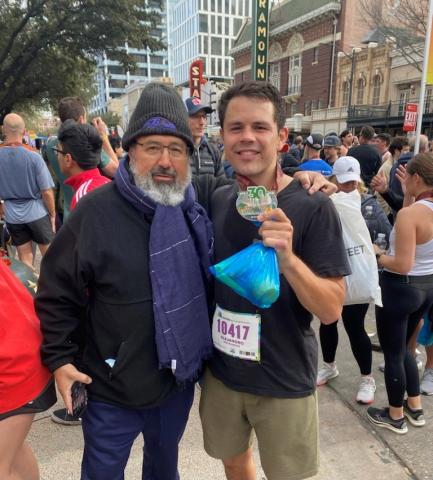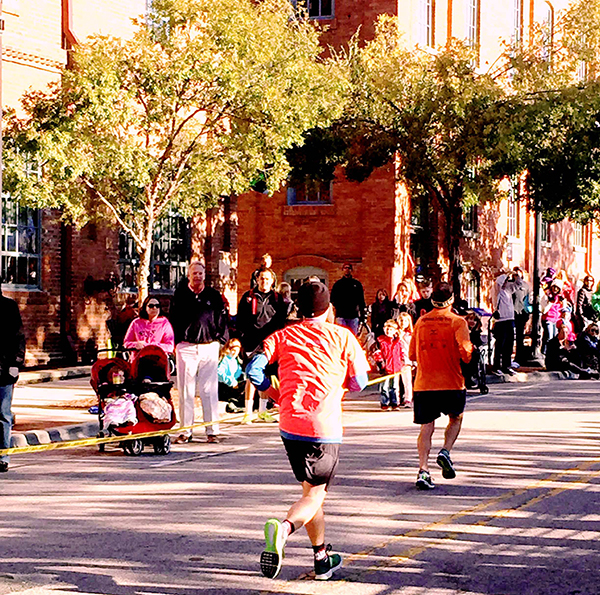On Marathons, Health, and Cities

While attending the 30th Austin Marathon on February 20th, 2022, not to run, but as a show of solidarity and encouragement to my second son, Alejandro, who ran a half marathon on a beautiful early spring morning in Texas, I felt a great deal of excitement, happiness, and pride.
Occasions like this bring the recognition, perhaps more than anything else that has changed as time has inexorably kept moving forward and I have gotten older, of the innate happiness that I derive from my children’s achievements. Indeed, when my son crossed the finish line, I was shouting, calling his name, cheering him on, and taking pictures with my cell phone to share with my wife, my other two children, and the extended members of my family. My emotions at that moment signaled immense joy that was overpowering, similar to what I felt cheering my first son, Carlos, doing a similar race in 2015 in Durham, North Carolina.
Besides completing the race in good time (less than 1 hour and 50 minutes), as his goal was during training in the previous months, participating in the race reinforced in my son once again the realization that despite his unexpected, out of nowhere, Type-1 Diabetes diagnosis six years ago this month while he was still in his late teenage years, challenges that alter your life can be faced and overcome with commitment to strict dietary and physical activity practices, adherence to regular blood sugar monitoring and the administration of insulin, disciplined work routines to achieve your professional goals (software development, in my son’s case), complemented by life-long learning to keep up with new technological developments, and an unshakable believe in sí se puede (or yes, we can).
In my case, while I am still working and contributing in areas that matter to me to help advance the global public health and environment agenda, although I formally retired three years ago, my physical capacity to run long distances is now a distant memory. But, besides accepting my limitations, I have been able to adjust to the new “normal” in my life, with a “little prodding” from my children and support from my wife, by walking at least 10,000 steps daily--the marker that I faithfully monitor in my cell phone.
During these past few days spent in Austin, I developed a renew conviction that increasing “healthy life expectancy” should be the main outcome of the health preparedness and building back better agendas going forward. Health-adjusted life expectancy (HALE) is the average number of years that a person can expect to live in full health—that is, not hampered by disabling illnesses or injuries.
After all the excess mortality and truncated lives experienced during the COVID-19 pandemic, some of them linked to the interplay of the novel coronavirus and pre-existing health risks and diseases, particularly among the elderly, supporting countries in the attainment of this outcome should be seen as a social and economic imperative for building less vulnerable and more resilient, inclusive, and prosperous societies. So, the goal should be centered in “keeping people healthy, both physically and mentally” rather than just waiting to “treat the sick.” Afterall, the wellbeing of people needs to be at the core of the development process.
The Imperative of Healthy Populations
The above observations are not new. Since 2015, we have witnessed a significant movement toward the goal of universal health coverage (UHC), highlighting the need to accelerate progress toward affordability of care and access to basic services. But to achieve these objectives post-pandemic and to ensure the financial sustainability of health and social support systems, which can be severely undermined by the uncontrolled outbreaks of disease and the rise of health care costs, it is imperative that a stronger push toward UHC include efforts to change lifestyle choices that contribute to increased health risks and the onset of preventable chronic diseases.
While this predicament should concern all countries across the income spectrum, low- and-middle income countries are more vulnerable as they face the twin challenges of chronic diseases and aging of the population in an increasingly urbanized landscape without the resource base, health systems, or coverage levels of high-income countries.
Charting a Course of Action
Are disease and injury prevention then the “cure” for this global predicament? In large measure this may be the case. However, this course of action requires a fundamental rethinking of how to best keep people healthy and out of the hospital.
For starters, there has to be a widespread realization among policymakers, employers, health insurers, service providers, and the population at large, that the lion’s share of health care expenditures goes for treating diseases and injuries that could be “prevented”. This demands priority attention for supporting population-wide efforts via taxation, regulation, and policy and institutional nudges to tackle social and behavioral determinants of ill health and premature mortality, such as policy measures to curb tobacco use, second hand smoke, e-cigarette addition among adolescents and youth, alcohol and substance use disorders, ingestion of sugary drinks and high-caloric foods, obesity, Type-1 and Type-2 diabetes, traffic injuries, and in some countries, gun violence and a growing opioid epidemic.
Insurance arrangements and health care organization and payment innovations that are already used in different countries, can be leveraged to further advance this public health agenda as well. For example, insurance companies, by charging lower premiums for those who quit smoking, lose weight, overcome sedentarism by increasing physical activity, and pass screening tests for artery-clogging cholesterol, high blood pressure, and high sugar levels, provide an incentive for individuals and families to assume responsibility for their health.
Health care innovations that promote care coordination among hospitals, physicians, nurses, therapists, and home care providers in accordance with evidence-based care protocols and that reimburse services using annual or capitated fees for members of an assigned population, can be scaled up to promote collaborative structures centered on ambulatory, community-based, primary care services. These arrangements have the potential to reduce costly emergency room visits and inpatient services through early detection and treatment of chronic diseases and by keeping people healthy and out of the hospital.
The use of smartphones and specialized apps can help keep people healthy, via text message reminders about medication schedules; keeping track of lab results and vital signs; and monitoring progress in achieving personal health goals; e.g., as in my case, monitoring every day the number of steps taken and comparing them with the steps taken the previous day or week.
At the workplace, employers could adopt and scale up on-site clinics as part of workplace health and wellness programs, covering both physical and mental health conditions, to help workers and their families access health promotion counseling to encourage physical activities and diet regimens and to provide secondary prevention services such as flu and COVID-19 vaccination, screening for high blood pressure and blood sugar levels, and psychosocial support for anxiety and depressive disorders and alcohol and substance use disorders.
The Role of Cities in Promoting Healthy Living
Austin, as an urban economy, is increasingly relying on intelligence and innovation. Indeed, the transformation of Austin into a high-tech hub is being driven by educated and skilled people and diverse state-of-the-art industries concentrated in space and time. In that sense, Austin stands as a good example of the “triumph of the city”, the greatest human invention as described by Prof. Edward Glaeser of Harvard University, that offer great opportunities to elevate the human condition. This achievement, however, requires, as he put it, “creative thinking” to guard against the drawbacks of high density living, including contagious diseases, crime, high housing costs, and homelessness.
While walking around Austin I saw concrete examples of that “creative thinking” in policy making that facilitate “healthy living” in the form of extensive trails and green space for walking and biking, enjoyed by people of all ages, both women and men, and of all income levels. Bike parking lots have been created, and road intersections re-engineered for safe pedestrian crossing and for bikes, on top of the scooter-sharing system that has been established.
The redesign of the urban space to facilitate pedestrian and cyclist mobility by rolling out new cycling networks and improving pedestrian walkways as done in Austin, can generate significant health benefits by reducing health risks associated with sedentary lifestyles while making cyclists and pedestrians safer. Indeed, regular and adequate levels of physical activity in adults lower the risk of hypertension, coronary heart disease, stroke, diabetes, breast and colon cancer, depression, and falls; they improve bone and functional health; and they are a key determinant of energy expenditure and thus fundamental to energy balance and weight control.
Supporting pedestrian-and bike-friendly policies, programs, and investments in cities, therefore, offers the potential to contribute to the reduction of traffic congestion and pollution, but also to improve the health of the population at different age groups.
Takeaway
As we start to visualize a “new normal” post-pandemic in 2022 and beyond, it is time to make the case for giving more attention to health promotion and disease prevention as part of scaling up universal health coverage and to building more resilient, less vulnerable societies. While not everybody will be able to have the capacity to run marathons, half-marathons, or 5K races, as a collective our goal should be the promotion of healthy populations and not simply more, better financed, health services for the sick. The realization of this goal, however, has to be a shared social responsibility as the determinants of good physical and mental health cut across all areas of human activity.
Source of Images: Photos provided by author for the events held n 2022 and 2015, respectively.

